The Supreme Court
OPINION V. OPINIONATED
Published January 18, 2022 • 8 min read
o•pin•ion (n.) a view or judgment formed about something, not necessarily based on fact or knowledge
Supreme Court Opinion (n.) The reasoning behind Justices' decisions that have wide ranging impacts on the possessions, finances, and livelihoods of millions of Americans across generations.
Now that is a powerful opinion.
However, it implicitly relies on the legitimacy of the Court. One individual opinion may not stand a chance against a Supreme Court opinion, but public opinion just might. With the Supreme Court of the United States’ (SCOTUS) approval rating plummeting to 40% according to Gallup’s September 2021 poll - a record low - the power of a Supreme Court opinion may be dwindling. Add to this the fact that States such as Texas and Mississippi have recently taken to undermining SCOTUS opinions with the ‘Texas Heartbeat Act’ and ‘Dobbs v Jackson Women’s Health Organization’ clearly undercutting ‘Roe v Wade.
So why has the Supreme Court lost so much of it’s clout?
Chief Justice Roberts’ year-end review sheds light on the underlying issue: maintaining “decisional independence (...) free from political or other extraneous influence”. However, the Supreme Court is either "too liberal" or "too conservative." The public seems to think that they are either accepting the wrong kinds of cases, or taking the ones that they do accept into a less-than-ideal direction. But, hey, that’s a matter of ‘opinion’.
Or is it? As a matter of fact, the choice of accepted cases alone can be an indicator of the partisan nature of the Court. The Supreme Court accepts about 1.5-2% of the 7000 cases it is presented with annually (totaling around 100-150), and these cases are chosen based on the ‘Rule of Four’ – meaning that at least four of the nine justices must believe the case to have merit. And with the current 6-3 Conservative supermajority, the cases for 2022 are already proving to be divisive topics, such as abortion access, gun rights, free speech, immigration, environmental protection, and vaccine mandates.
What is the Supreme Court ruling on?
Given that the outcomes of these cases can have colossal influence on the American way of life, the justices’ opinions – which elaborate on the reasoning of the decision made — are heavily scrutinized and analyzed by specialists. These opinions are readily available to the public, yet it remains a daunting task to read through and make sense of the dozens of opinions that are released annually, let alone the thousands that have accumulated since its establishment in 1789. However, if we take a different approach and visualize them on a single screen, we can easily begin to grasp the scope, scale, and sequence of SCOTUS opinions, and possibly gain hints as to how they might lean on future cases.
While every opinion in the Supreme Court’s history has the potential to be hugely influential, let’s take a look at a sampling of a 50 year period from 1970-2020 representing the three most recent Courts under Chief Justices Burger (1970 -1986 • moderate), Rehnquist (1986 – 2005 • conservative), and Roberts (2005 – present • conservative).
The full text of the 10,985 opinions were run through VAULENEX algorithms, which starts by grouping the documents together into clusters based on semantic similarities. After further calculations and the final step visualizing the data, we are provided with a well-defined radar showing document density and layout where distance indicates the degree of similarity (but note that the axes have no meaning), along with some auto-generated machine intelligence output such as the key areas including Major (higher density regions) and Growing (fastest growth over the past 5 years) regions on the radar. For simplicity, the cluster layer has been turned off to ensure the full clarity of the heatmap.
CRIME AND PUNISHMENT: from suspicion to sentencing
Fig 1 • All Supreme Court Opinions between 1970 - 2020
At first glance, we can see that cases accepted by the Supreme Court cover a wide range of topics, which can be broadly grouped by constitutional amendments. The highest concentration pertains to the Fourth and Fifth Amendments (relating to searches and seizures, and self-incrimination and double jeopardy respectively) as well as the Sixth to Eighth Amendments (concerning trial procedures and sentencing) visible on the left side of the radar in and around the Major areas. The other major area of concentration visible on the top right of the radar represents Labor Union cases, flanked by other areas mostly relating to matters of employment and the workplace. And while two Growing areas were detected - one on the left relating to Double Jeopardy clauses and on the right relating to employer negligence - the lack of issues pertaining to other growing societal concerns is very apparent. We’ll delve further into this point later on.
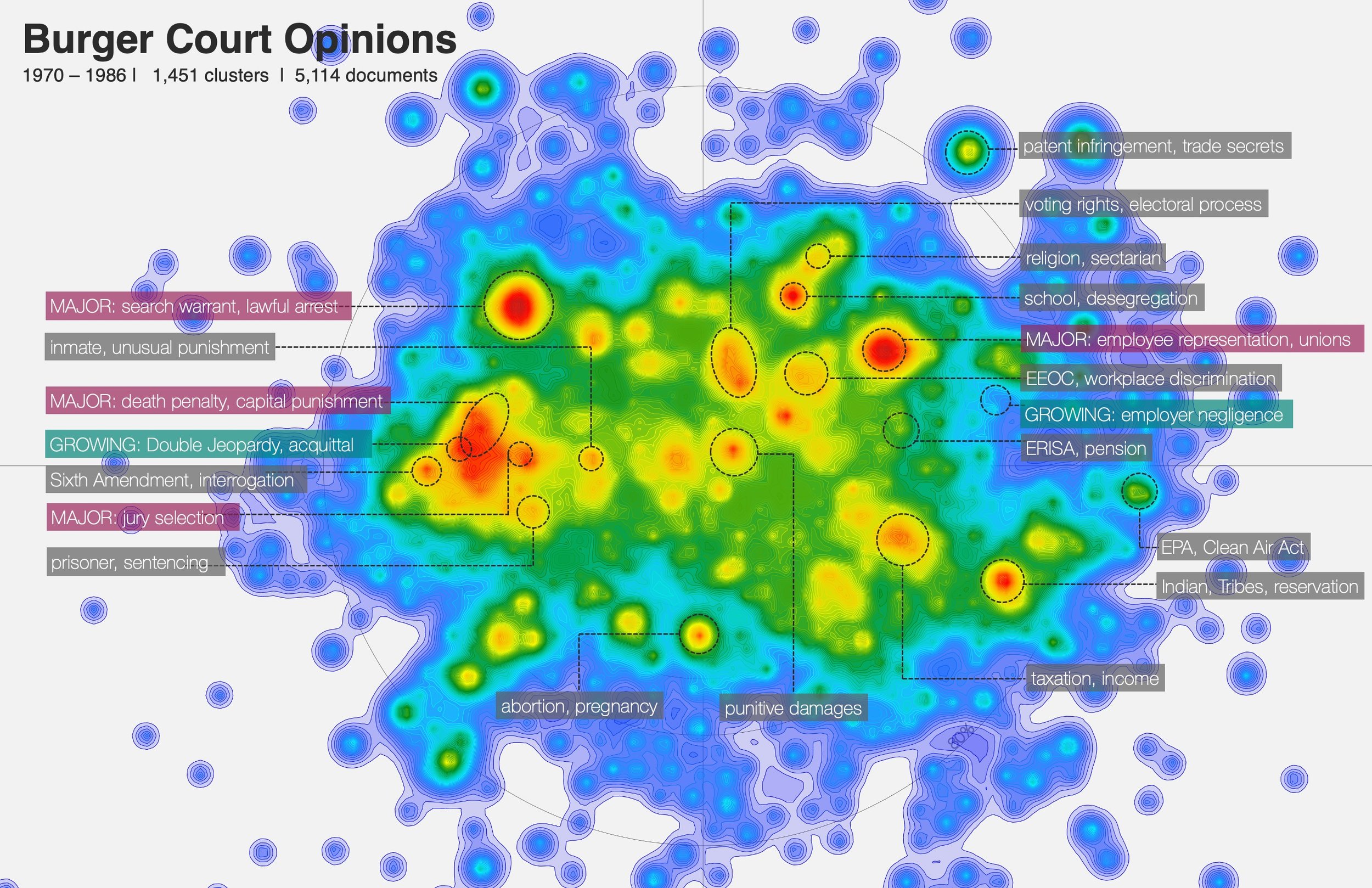
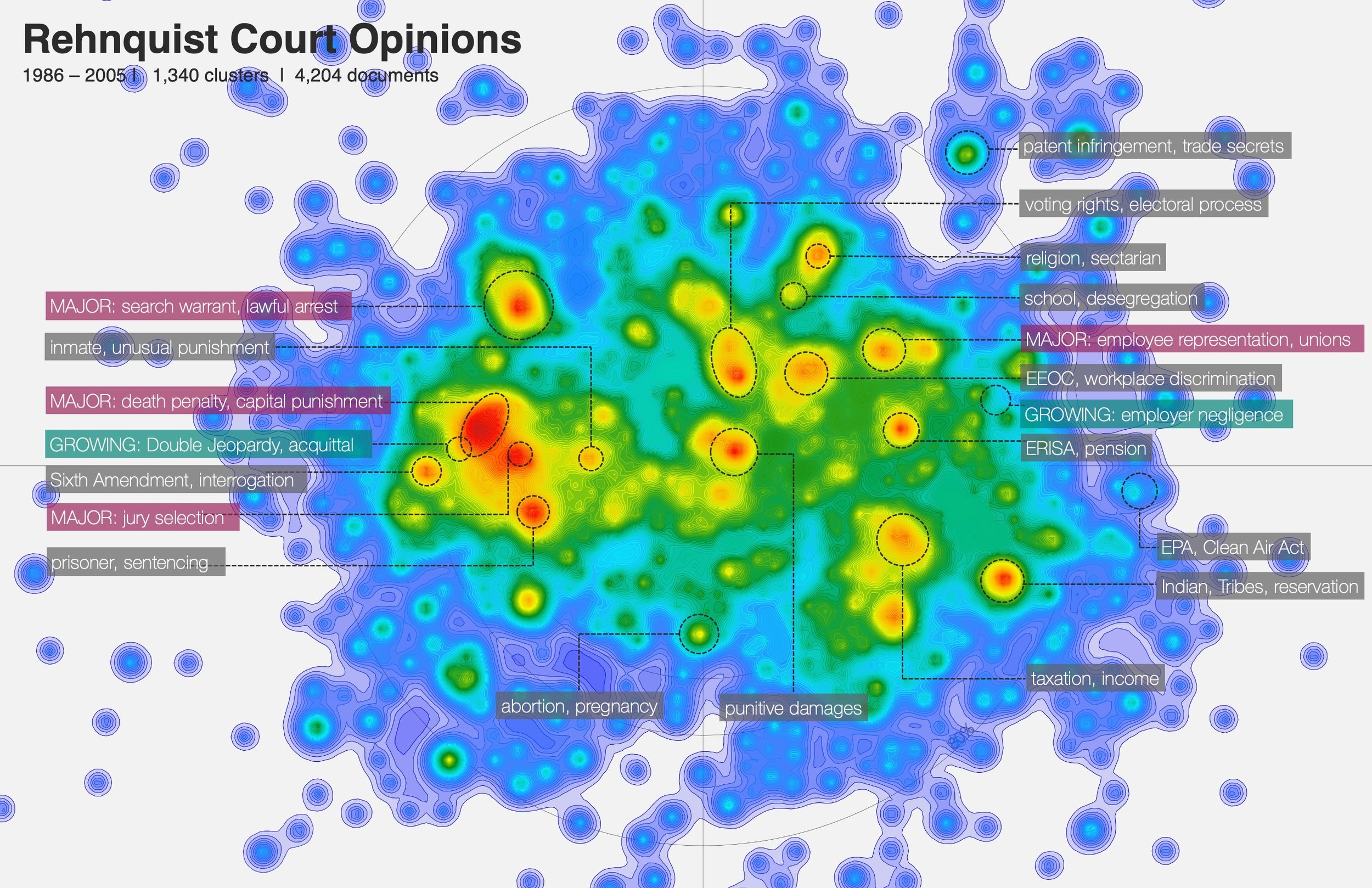
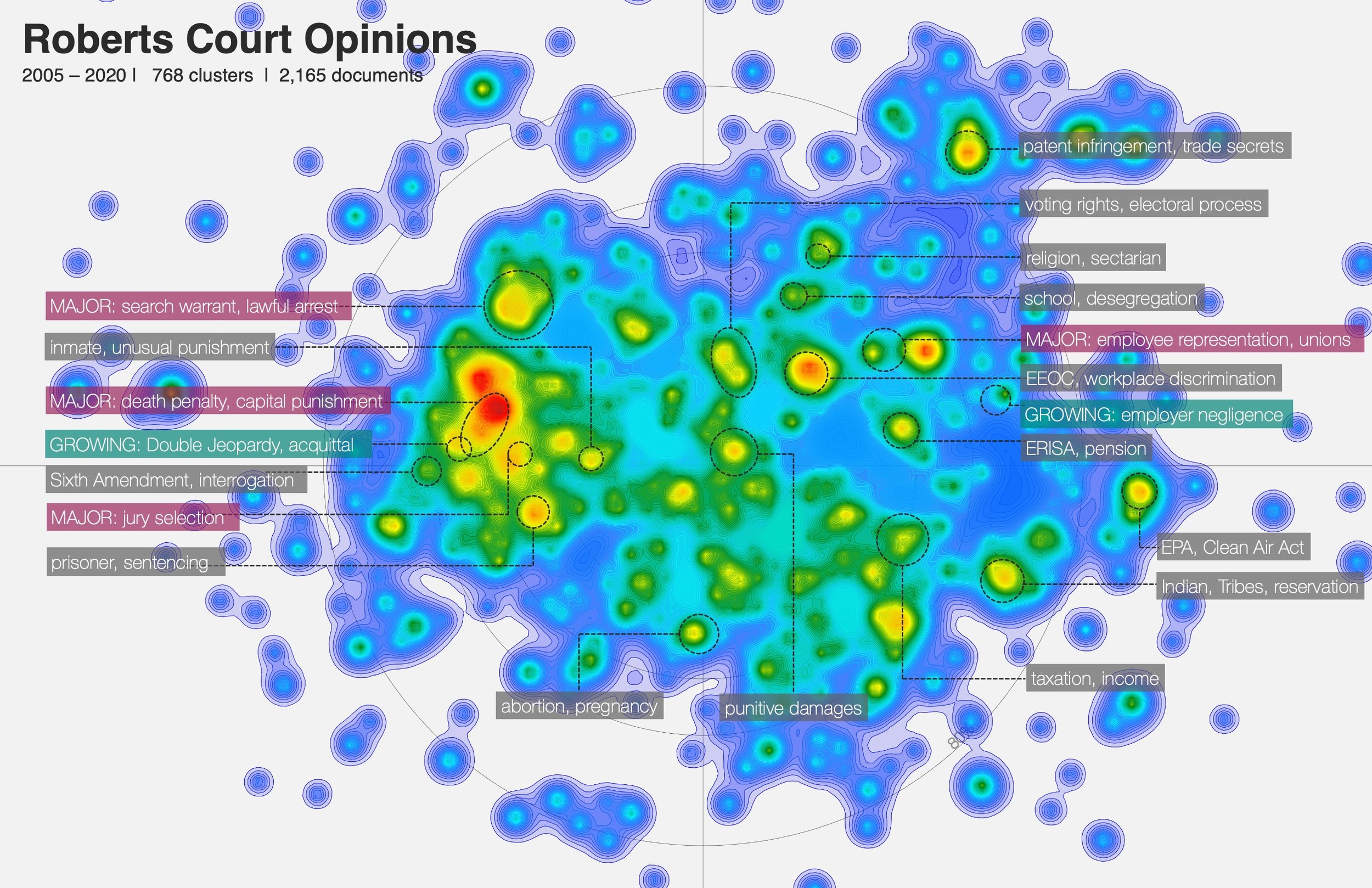
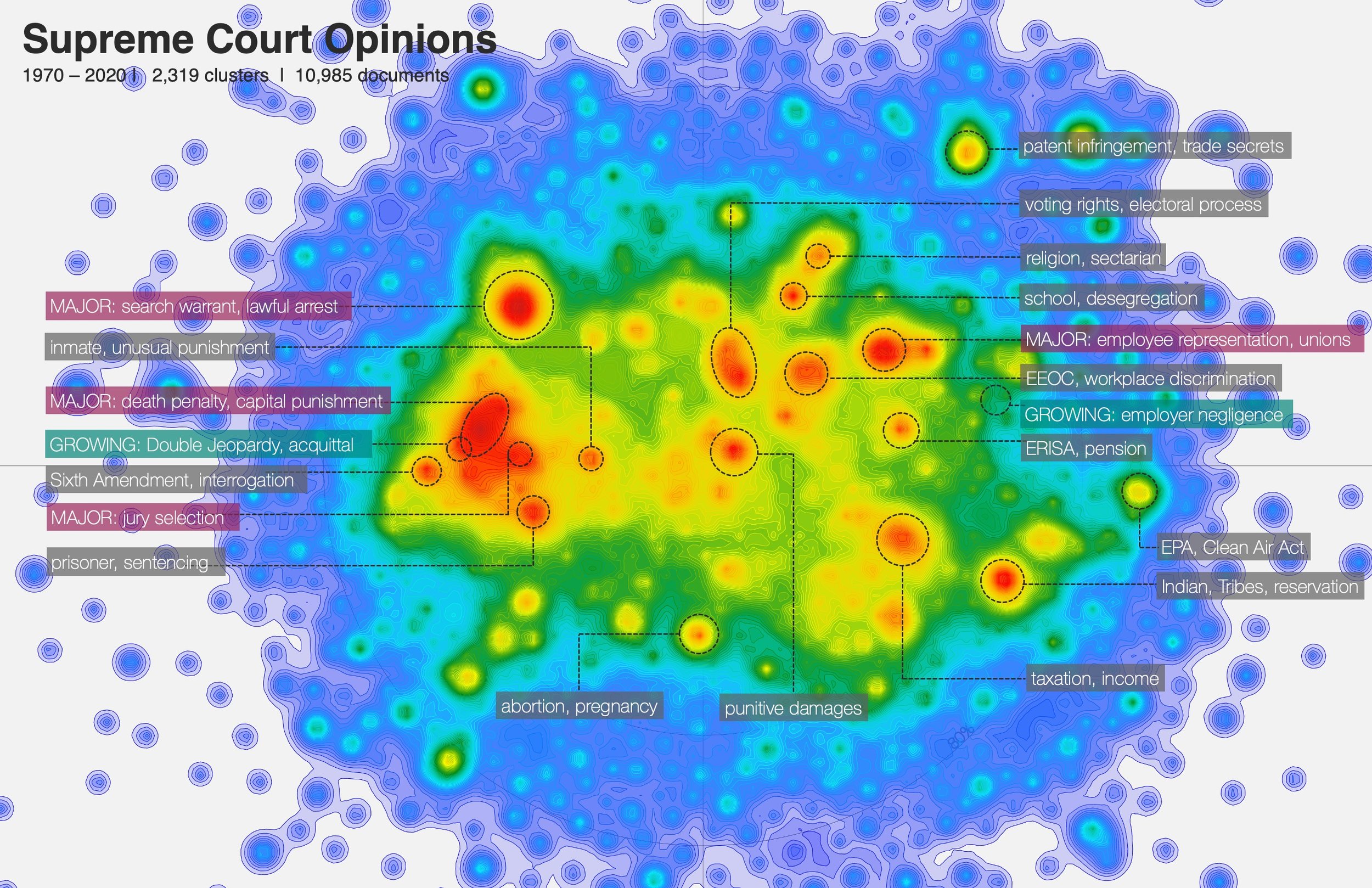
From there, by isolating documents based on the specific years of a court’s term we can begin revealing the emphasis of that court’s dealings. One of the most noticeable changes is the dramatic decline in Labor Union cases after the Burger Court (1970-1986), which mirrors the sharp decline of unionism in the US with the progression of globalization in the 1970s. Although the Fourth and Fifth Amendments remain the Court’s priorities, the focus within these areas has shifted with time: the Burger Court was most preoccupied with the Fourth Amendment – notably Katz v United States (7-1 majority) – which expanded the protection of Fourth Amendment rights to include the “reasonable expectation of privacy”.
The Rehnquist Court (1986-2005), on the other hand, took an active interest in death penalty cases – notably the controversial McCleskey v Kemp (5-4 majority) about racial discrimination in face of capital punishment, but also Roper v Simmons (5-4 majority) which abolished capital punishment for minors.
Finally, the Roberts Court (2005-present) seems to be more active in areas related to aggravated felony and the Armed Career Criminal Act of 1984 (ACCA), as well as cases related to maximum prison terms. It is worth noting that these high density areas can represent a large number of cases on the same topic, as well as diverging opinions about the same case (showing dissent and/or disagreements in majority reasoning).
THE AMERICAN DREAM: freedoms and gun rights
As revealing as the areas of high density are, it is also pertinent to note the sparse areas or those with little-to-no mention. The cases related to the First Amendment (freedom of speech, religion, press, and right to assembly) are actually the most numerous, but cover such a large scope that their density remains relatively low, with the main areas of activity being about voting rights, public advertising, and religion.
Also, with gun rights and gun control being a flaming hot topic in the press, rulings about them remain noticeably absent. Yes, there are some mentions of ‘guns’, ‘firearms’, and even ‘machine guns’, but only two cases appear to explicitly reference the Second Amendment: District of Columbia v Heller (5-4 majority • 2008) and McDonald v Chicago (5-4 majority • 2010). This doesn’t mean that cases regarding gun rights aren’t presented to the Supreme Court. Quite to the contrary; in June 2020 alone, the Court refused to hear 10 cases seeking to expand gun rights. So it is particularly remarkable that the Supreme Court accepted and will be ruling on a gun rights case (New York State Rifle & Pistol Association v Bruen) in 2022, now that it has a Conservative supermajority of 6-3.
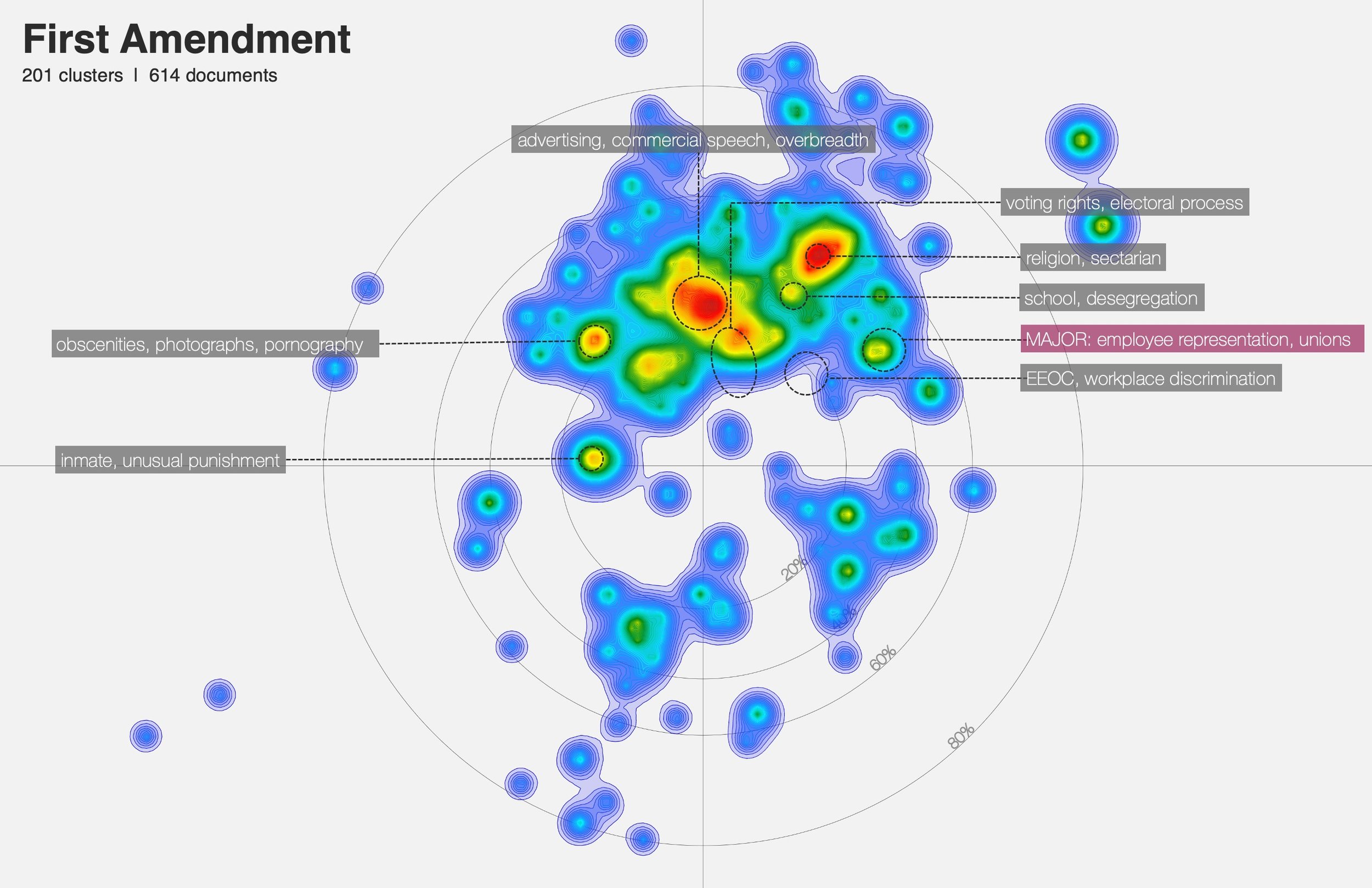
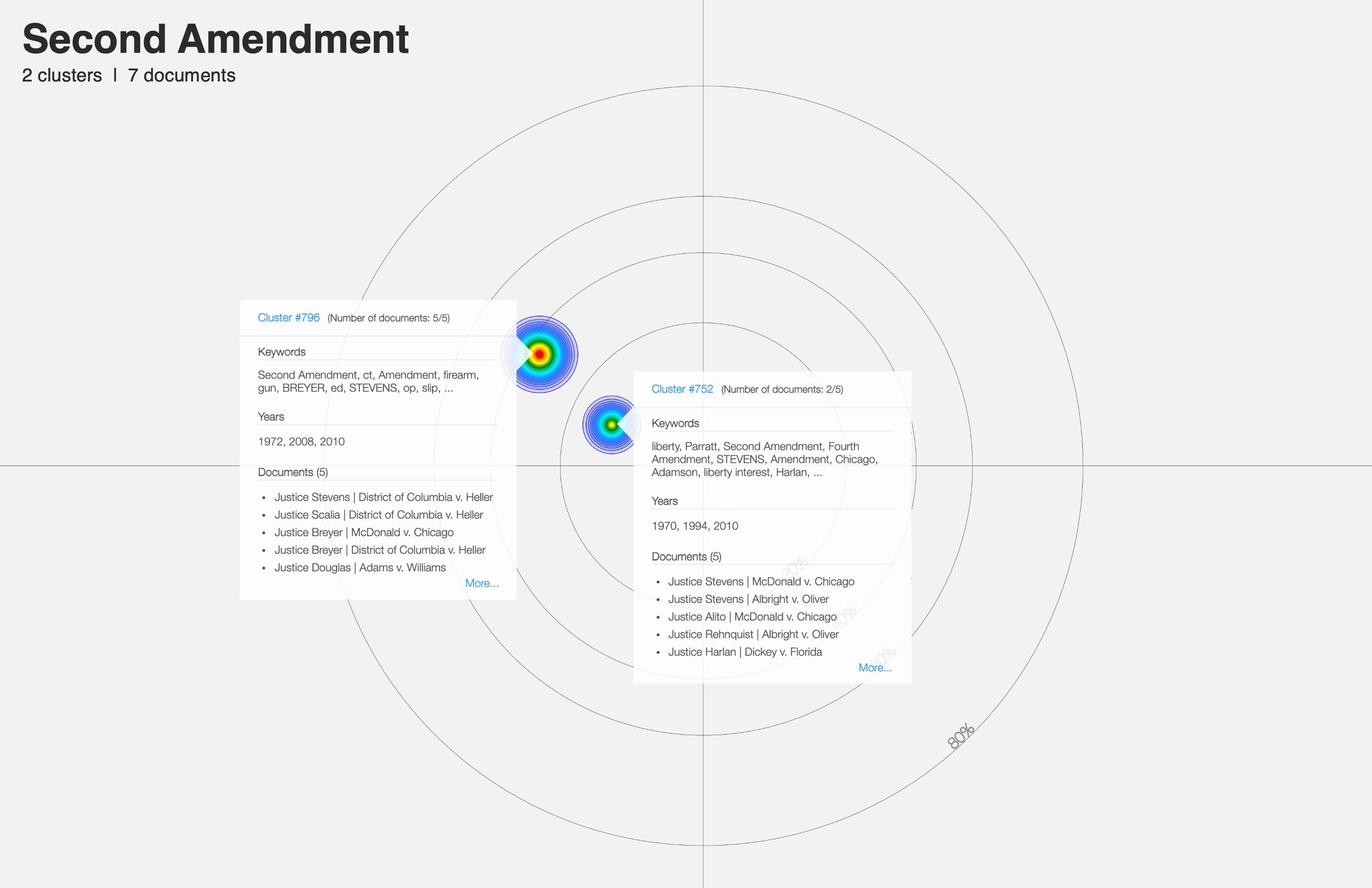
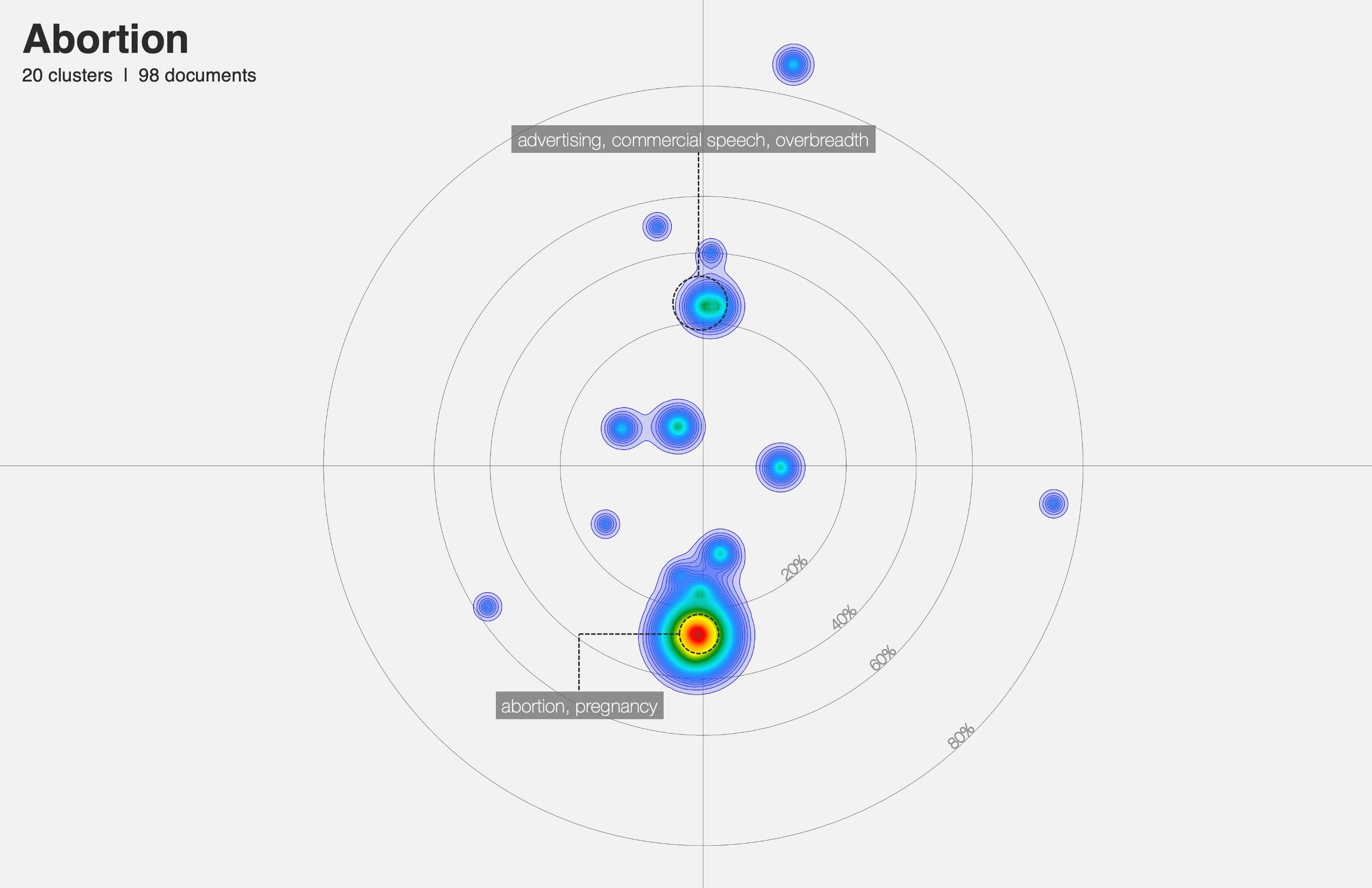
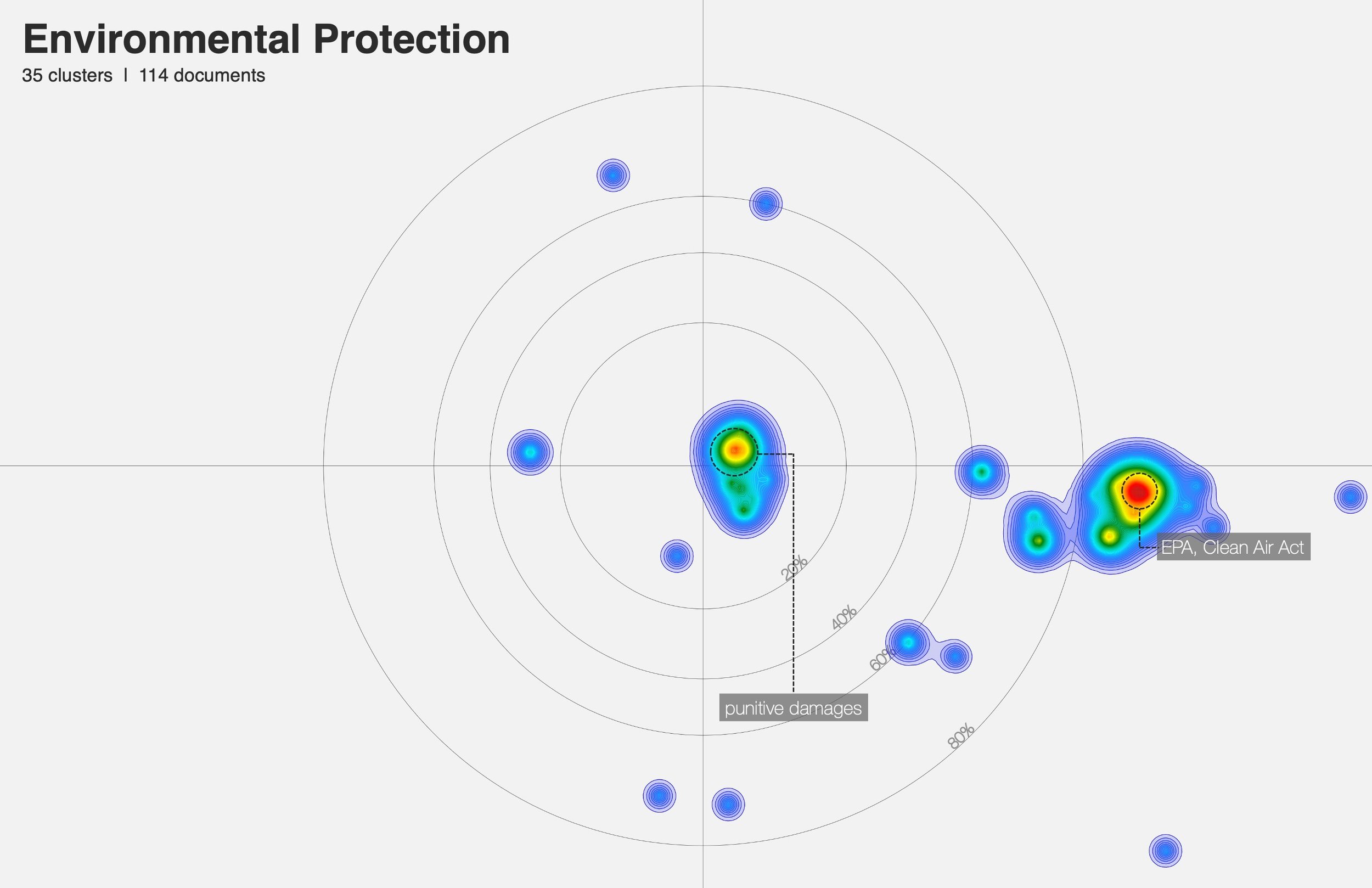
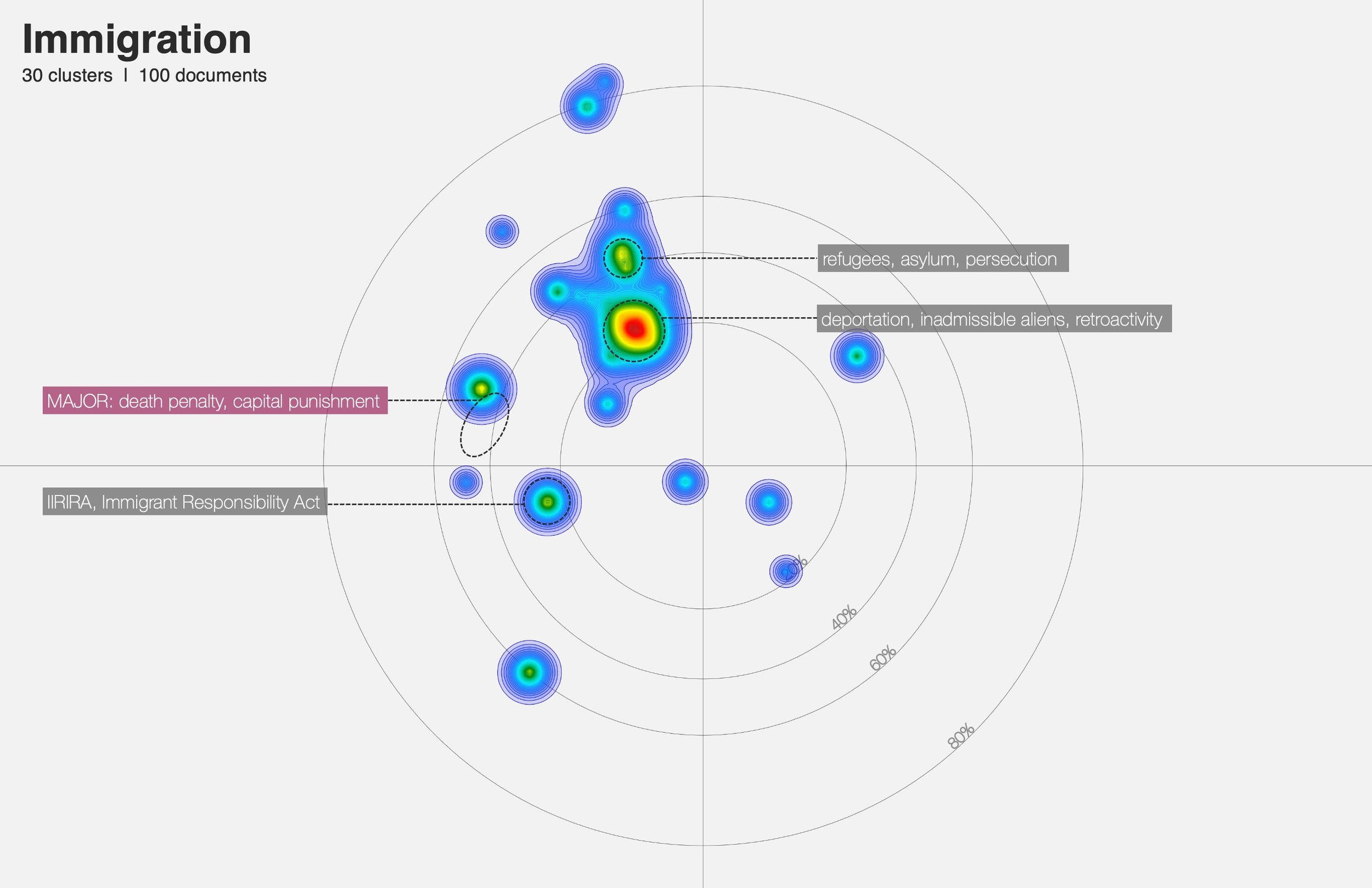
THE CUSTOM OF THE COUNTRY: societal issues
The same limited opinions around environmental issues, abortion, and immigration is a stark indicator that the Court has been reticent to accept cases for topics that move the dial on progressive societal issues. However, these topics have recently been more prevalent with the rising occurence of the ‘shadow docket’ - an extraordinary procedure which doesn’t require oral arguments and can be resolved in a matter of weeks without the need to publish opinions.
Indeed, rulings on topics such as the environment (Clean Power Plan • 2016), discrimination in the military (Memorandum on Military Service by Transgender Individuals • 2017), immigration (Trump Travel Bans • 2017), and abortion (Texas Heartbeat Act • 2021) have been all but overturned through shadow dockets, and thus will not appear on the radar. The opacity surrounding decisions on what the public may see as high priorities has not helped bolster the Supreme Court’s legitimacy. And with the rise in these controversial shadow dockets, we begin thinking that white space - holes and potentially blank regions - will start to appear in the radar as these unpublished rulings become more numerous, giving even deeper insight into the inner workings of the court.
o•pin•ion•at•ed (n.) firmly or unduly adhering to one's own opinion or to preconceived notions
The timing of these attacks to precedents, such as Roe v Wade with the Texas Heartbeat Act directly undermining it, and the selection of highly partisan cases for the up-coming term have not gone unnoticed, as they come after the contentious nomination of three Trump-selected justices, chosen specifically because of their public statements and stances on issues such as abortion, gun-control, and the environment. The nomination of judges who have been outspoken on their beliefs calls into question the supposed impartiality and apolitical nature of the Supreme Court.
As the steady flow of opinions continues to be released, one wonders if regions around these hot topics will indeed intensify on the heatmap, emerge as growing areas, linger in the darker areas of the radar, or evolve into clear voids. Certainly, time will tell and we will be able to see it.
